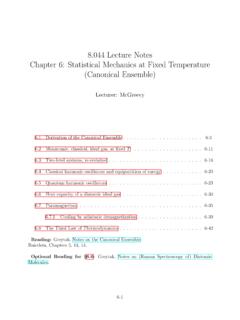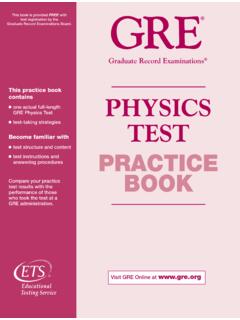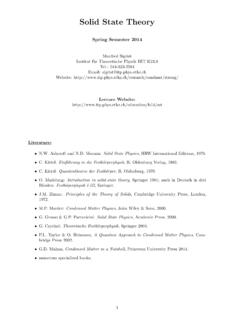Transcription of The Calculus of Variations - City University of New York
1 The Calculus of VariationsM. Bendersky Revised, December 29, 2008 These notes are partly based on a course given by Jesse Introduction. Typical Problems52 Some Preliminary Results. Lemmas of the Calculus of Variations103 A First Necessary Condition for a Weak Relative Minimum: The Euler-LagrangeDifferential Equation154 Some Consequences of the Euler-Lagrange Equation. The Weierstrass-ErdmannCorner Some Examples256 Extension of the Euler-Lagrange Equation to a Vector Function, Y(x)327 Euler s Condition for Problems in Parametric Form (Euler-Weierstrass Theory) 368 Some More Examples449 The first variation of an integral,I(t) =J[y(x, t)] = x2(t)x1(t)f(x, y(x, t), y(x,t) x)dx; Application to Fields of Extremals and Hilbert s Invariant The Necessary Conditions of Weierstrass and Conjugate Points,Focal Points, Envelope Theorems6913 Jacobi s Necessary Condition for a Weak (or Strong) Minimum: GeometricDerivation7514 Review of Necessary Conditions, Preview of Sufficient More on Conjugate Points on Smooth The Imbedding The Fundamental Sufficiency Sufficient Some more The Second Variation.
2 Other Proof of Legendre s Jacobi s Differential One Fixed, One Variable End Both End Points Variable11924 Some Examples of Variational Problems with Variable End Points12225 Multiple Integrals12626 Functionals Involving Higher Derivatives13227 Variational Problems with Functionals of Vector Functions: Fields, Hilbert Integral, Transversality inHigher The Weierstrass and Legendre Conditions forn 2 Sufficient The Euler-Lagrange Equations in Canonical Hamilton-Jacobi Field Integrals and the Hamilton-Jacobi Equation.. Characteristic Curves and First Integrals .. A theorem of Jacobi.. The Poisson Bracket.. Examples of the use of Theorem ( ) .. 19032 Variational Principles of Further Topics:19541 Introduction. Typical ProblemsThe Calculus of Variations is concerned with solvingExtremal Problemsfor aFunc-tional. That is to say Maximum and Minimum problems for functions whose domain con-tains functions,Y(x) (orY(x1, x2), orn-tuples of functions).
3 The range of the functionalwill be the real numbers, two pointsP1= (x1, y1), P2= (x2, y2) in the plane, joined by a curve,y=f(x).The Length Functionalis given byL1,2(y) = x2x1 1 + (y )2dx ds. The domain is the set of allcurves,y(x) C1such thaty(xi) =yi, i= 1,2. The minimum problem forL[y] is solved bythe straight line (Generalizing I)The problem of Geodesics, (or the shortest curve between two givenpoints) on a given surface. on the 2-sphere they are the shorter arcs of great circles(On the Ellipsoid Jacobi (1837) found geodesics using elliptical co ordinates in terms ofHyperellipticintegrals, af( a0+a1x+ a5x5dx, frational ). the plane, given points,P1, P2find a curve of given length`(>|P1P2|) which togetherwith segmentP1P2bounds a maximum area. In other words, given`= x2x1 1 + (y )2dx,maximize x2x1ydxThis is an example of a problem with given constraints (such problems are also called5isoperimetric problems).)
4 Notice that the problem of geodesics fromP1toP2on a givensurface,F(x, y, z) = 0 can also be formulated as a variational problem with constraints:GivenF(x, y, z) = 0 Findy(x), z(x) to minimize x2x1 1 + (dydx)2+ (dzdx)2dx,wherey(xi) =yi, z(xi) =zifori= 1, , P2in the plane, find a curve,y(x) fromP1toP2such that the surface of revolutionobtained by revolving the curve about thex-axis has minimum surface area. In other wordsminimize 2 P2P1ydswithy(xi) =yi,i= 1,2. IfP1andP2are not too far apart, relative tox2 x1then the solution is a Catenary(the resulting surface is called a Catenoid).Figure 1: CatenoidOtherwise the solution is Goldschmidt s discontinuous solution(discovered in 1831) ob-tained by revolving the curve which is the union of three lines: the vertical line fromP1to the point (x1,0), the vertical line fromP2to (x2,0) and the segment of thex-axis from(x1,0) to (x2,0).
5 6 Figure 2: Goldscmidt Discontinuous solutionThis example illustrates the importance of the role of the category of functions we restrict to continuous curves then there is a solution only if the points are the points are far apart there is a solution only if allow piecewise continuous curves ( except possibly for finitelymany jump discontinuities. There are similar meaningsfor piecewise classCn.)The lesson is that the class of unknown functions must be precisely prescribed. If othercurves are admitted into competition the problem may change. For example the onlysolutions to minimizingL[y] def ba(1 (y )2)2dx, y(a) =y(b) = polygonal lines withy = Brachistochroneproblem. This is considered the oldest problem in the Calculus ofVariations. Proposed by Johann Bernoulli in 1696: Given a point 1 higher than a point 2in a vertical plane, determine a (smooth) curve from 1 2 along which a mass can slide7along the curve in minimum time (ignoring friction) with the only external force acting onthe particle being physical principles may be formulated in terms of variational problems.
6 Specificallytheleast-action principleis an assertion about the nature of motion that provides an alter-native approach to mechanics completely independent of Newton s laws. Not only does theleast-action principle offer a means of formulating classical mechanics that is more flexibleand powerful than Newtonian mechanics , but also Variations on the least-action principlehave proved useful in general relativity theory, quantum field theory, and particle a result, this principle lies at the core of much of contemporary theoretical problemIn the plane, find among all closed curves,C, of length`theone(s) of greatest area (Dido s problem) representing the curve by (x(t), y(t)): given`= C x2+ y2dtmaximizeA=12 C(x y xy)dt(recall Green s theorem). SurfacesGiven a simple, closed curve,CinR3, find a surface, say of classC2,bounded byCof smallest area (see figure 3).
7 8 Figure 3:Assuming a surface represented byz=f(x, y), passes throughCwe wish to minimize R 1 + ( z x)2+ ( z y)2dxdyProving the existence of minimal surface is Plateau s problem which was solved by JesseDouglas in Some Preliminary Results. Lemmas of the Calculus of Varia-tionsNotation the category of piecewise continuous functions on[x1, x2].by C[x1, x2]Lemma (Fundamental or Lagrange s Lemma) LetM(x) C[x1, x2].If x2x1M(x) (x)dx=0for all (x)such that (x1) = (x2) = 0, (x) Cn,0 n on[x1, x2]thenM(x) = 0at all points of :. Assume the lemma is false, sayM(x)>0,Mcontinuous atx. Then there exista neighborhood,Nx= (x1,x2) such thatM(x) p >0 forx Nx. Now take 0(x) def 0,in [x1, x2] outsideNx(x x1)n+1(x2 x)n+1,inNxThen 0 Cnon [x1, x2] and x2x1M(x) 0(x)dx= x2x1M(x) 0(x)dx p x2x1(x x1)n+1(x2 x)n+1dx 0 For the casen= take 0 0,in [x1, x2] outsideNxe1x x2e1x1 x, (x) C[x1, x2].
8 If x2x1M(x) (x)dx= 0for all (x)such that C , (x1) = (x2) = 0thenM(x) =con its set of :(After Hilbert, 1899) Leta, a be two points of continuity ofM. Then forb, b withx1< a < b < a < b < x2we construct aC function1 1(x) satisfying 0,on [x1, a] and [b , x2]p(a constant>0),on [b, a ]increasing on [a, b],decreasing on [a , b ]Step 1: Let 0be as in lemma ( ) 0= 0,in [x1, x2] outside [a, b]e1x x2e1x1 x,in [a, b]Step 2: For somecsuch thatb < c < a andx1 x cset 1(x) =p ba 0(t)dt xa 0(t)dtSimilarly forc x x2define 1(x) by 1(x) =p b a 0(t)dt b x 0(t)dtwhere 0(x) is defined similar to 0(t) with [a , b ] replacing [a, b].Now x2x1M(x) 1(x)dx= baM(x) 1(x)dx+ b a M(x) 1(x)dxwhereM(x) is continuous on [a, b],[a , b ]. By the mean value theorem there are [a, b], [a , b ] such that the integral equalsM( ) ba 1(x)dx+M( ) b a 1(x)dx=p(M( ) 1 IfMwere differentiable the lemma would be an immediate consequence of integration by ( )).
9 By the hypothesis this is 0. Thus in any neighborhood ofaanda there exist , such thatM( ) =M( ). It follows thatM(a) =M(a ). 1in lemma ( ) may be assumed to be inCn. One uses theCnfunction from lemma( ) in the proof instead of theC function. It is the fact that we imposed the endpoint condition on the test functions, , thatallows non-zero constants forM. In particular simply integrating the bump functionfrom lemma ( ) does not satisfy the condition. The lemma generalizes to:Lemma (x)is a piecewise continuous function such that x2x1M(x) (n)(x)dx= 0for every function that has a piecewise continuous derivative of ordernand satisfies (k)(xi) = 0, i= 1,2, k < nthenM(x)is a polynomial of degreen 1.(see [AK], page 197).Definition normed linear spaceDn(a, b) consist of all continuous functions,y(x) Cn[a, b]2with bounded norm||y||n=n i=0maxx1 x x2|y(i)(x)|.
10 3If a functional,J:Dn(a, b) Ris continuous we sayJis continuous with respect have continuous derivatives to ordernexcept perhaps at a finite number of ||y||nis a norm becausefis assumed to be continuous on [a, b].12 The first examples we will study are functionals of the formJ[y] = baf(x, y, y ) the arc length functional. It is easy to see that such functionals will be continuous withrespect toD1but are not continuous as functionals fromC R. In general functionalswhich depend on then-th derivative are continuous with respect toDn, but not with respecttoDk, k < assume we are given a function,f(x, y, z) say of classC3forx [x1, x2], and foryinsome interval (or region,G, containing the pointy= (y1, y2, , yn)) and for all realz(orall real vectors,z= (z1, z2, , zn)).Consider functions,y(x) D1[x1, x2] such thaty(x) G. LetMbe the set of all suchy(x).



